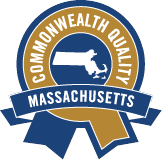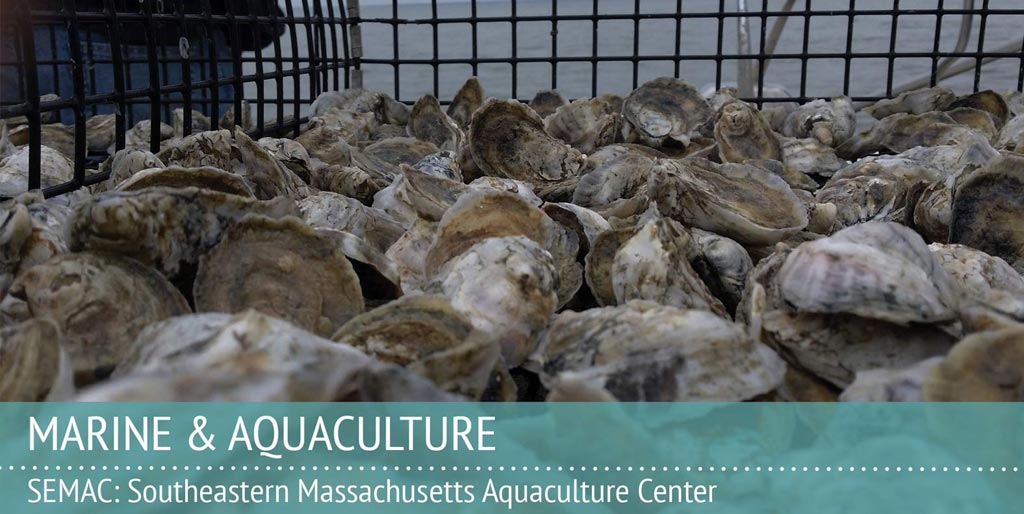
SEMAC
SEMAC MISSION
The mission of the Southeastern Massachusetts Aquaculture Center (SEMAC) is to foster the sustainable development of private/public aquaculture endeavors within the southeastern region and throughout the Commonwealth of Massachusetts by way of a coordinated effort including education, research, technical and economic assistance, best management practices and demonstration projects.
Aquaculture Production
Most aquaculture in Massachusetts is for shellfish, and the two main species grown are American oysters (Crassostrea virginica) and quahogs a.k.a. hard clams (Mercenaria mercenaria). The official statistics of shellfish production are kept by the MA Division of Marine Fisheries and are presented within their annual reports.
Barnstable County (Cape Cod)
According to the most recent data available (2021), 265 growers produce shellfish in Barnstable County on 717.1 acres. Fifty three (53) percent of the Commonwealth’s shellfish aquaculture acreage is located in Barnstable County. Over 31.6 million oysters were landed with a value of almost $17 million. These numbers are greatly increased from landings in 2020. Over 4.3 million quahogs (hard clams) were landed with a value of just over $1.3 million.
Commonwealth of Massachusetts
In 2021, a total of 398 aquaculture growers cultivated 1352.3 acres of area in Massachusetts. The value of the oyster industry was over $29.6 million, a rebound from the pandemic-driven losses in 2020 ($17+ million) and an increase from the pre-pandemic industry value in 2019 ($29 million). The value of the quahog industry (hard clams) was over $1.3 million, an increase of 21% from 2020. People also grew soft shell clams, blue mussels, scallops, surf clams, and a type of seaweed called sugar kelp.
Aquaculture is the 5th highest valued agriculture product in the Commonwealth of Massachusetts according to the 2017 USDA Census of Agriculture.
With funding from the Department of Agricultural Resources Aquaculture Program, the Southeastern Massachusetts Aquaculture Center (SEMAC) has been issuing a mini grant request for proposals since 1998. These mini grants fund projects which advance the aquaculture industry or address an industry problem.
At this time no funding is available for mini grant projects in 2018-2019. Please check this page for further updates, or send an email to Josh Reitsma if you would like to be contacted about future mini grant opportunities.
- Mini Grant Projects 1998-2012 – Searchable Spreadsheet
This spreadsheet contains the titles of all 144 Mini Grant projects that were funded from 1998-2012, sorted by topic, town, species, and year. If you would like more information about any of these projects, please email Abigail Archer at aarcher@capecod.gov. In this version, the information is grouped by topic. To group the projects by town, species, or year, download a copy of the spreadsheet to your computer, and then use the “Sort&Filter” button on the top right hand corner of the menu bar. Select the column you want to sort the data by, click the “Sort& Filter” button, and when the question box pops up make sure, “Expand the selection” is checked and then hit the button that says, “Sort”.
- 2012 List of SEMAC Mini Grant Projects
- 2011 Mini Grant Summary Report
- Video – Demonstration of Shoulder Height Bag Jig
- 1998 Mini Grant Summary Report
The Research Farm Network (RFN) is a SEMAC sponsored program that began in 2005 to generate useful data regarding shellfish culture methodology. The goals of the RFN are to:
1) provide high quality, relevant data to local shellfish farmers
2) provide multiple ‘platforms’ for demonstration and outreach in different communities
3) increase communication among shellfish farmers in southeastern Massachusetts
The program is based on the model of the Umass Cranberry Station. Every year shellfish growers can apply to be part of the program and participate in the chosen experiment. The network of research farms allows for testing of aquaculture methods in many different geographic areas using the same protocols. This allows shellfish farmers and researchers to gain a better idea of what methods are universally or locally better for production.
Below are reports on some of the experiments conducted.
- 2017-2019 RFN Project
Growing Methods for Petite Atlantic Surfclams - See the Fall 2016 SEMAC Newsletter and the SEMAC Tidings Fall 2017 Newsletter for an update on the 2015 & 2016 RFN project on handling small oyster seed in bags instead of an upweller.
- 2011-2012 RFN Project
Comparison of Bottom and Floating Gear for Growing American Oysters in SE Mass - 2008-2010 RFN Project – Effect of Triploidy on Oyster Growth and Survival
Seedless Oyster MDAR Final Report_2011
A major threat to the success of the shellfish aquaculture industry, as well as the public fishery, is disease. Our program actively responds to reports of disease outbreaks, and provides assistance with the costs of testing for natural resource managers and (in cases of new outbreaks) shellfish farmers. Though there are a number of conditions which can be problematic to shellfish, there are specific diseases of concern around Cape Cod and New England. Oyster diseases include Juvenile Oyster Disease (JOD), Dermo (Perkinsus marinus), MSX or Multinucleated Sphere Unkown (Haplosporidium nelsoni), and SSO or Seaside Organism (Haplosporidium costale). In quahogs the major pathogen is QPX, or Quahog Parasite Unknown, and as its name indicates is an organism which is still being researched. Heavy soft shell clam mortality has sometimes been attributed to a condition called hemocytic neoplasia, and the causal agent of this disease is still being determined. With the help of other researchers, we have developed an informational brochure to aid in awareness of these diseases and management practices (see below). For a full list of all available brochures including common pests and predators to shellfish, see the documents page.
Management of QPX
Though preventing of the spread of quahog disease QPX is the best management practice, a number of regional shellfish farmers need to develop culture management methods that improve survival despite the presence of QPX in their area. We have conducted field experiments testing the effects of planting density, comparing seed from two hatcheries, and differences between plots which are tended (with dead & dying clams removed) or not. We also continue to be involved with investigation of new concerns and management issues as they develop.
Working cooperatively with the industry and concerned user groups in the region, SEMAC drafted best management practices for the industry to encourage environmentally friendly and economically sustainable shellfish aquaculture.
Another set of Best Maintenance Practices is also available through the efforts of the East Coast Shellfish Growers Association (ECSGA) and funded through the USDA’s National Institute of Food and Agriculture, the Northeast Regional Aquaculture Center, and NOAA’s Office of Aquaculture.
Best Management Practices for the East Coast Shellfish Aquaculture Industry June 2010
If you are interested in shellfish restoration, BMPs are available through the International Shellfish Sanitation Conference.
Best Management Practices for Shellfish Restoration 2011
If you have questions about any of these documents please contact the Marine Program office.
Massachusetts Aquaculture Economic Impact Study
SEMAC staff worked with Umass Dartmouth Charlton College of Business, Center for Marketing Research graduate students Kevin Augusto and Glenn Holmes and their professor Dr. Nora Barnes to investigate the economic impact of the shellfish aquaculture industry in Massachusetts. A survey with 11 questions was mailed to all 334 aquaculture leaseholders in the state. One hundred and eighteen responded yielding a response rate of 35%. Similar studies in other states report response rates of less than 15%. Read the full report here: MA Aquaculture Economic Impact Study 2015
Alternative Shellfish Species Research Study
In 2014 SEMAC staff worked with the Umass Dartmouth Charlton College of Business, Center for Marketing Research to research the demand for alternative species of shellfish among wholesale shellfish dealers in Massachusetts. Five Umass Dartmouth undergraduate students who are majoring in marketing worked with their professor Dr. Nora Barnes to develop a set of 12 survey questions. They then contacted over 100 wholesalers by phone. In December they presented the results to SEMAC. A copy of their report can be downloaded here: Wholesale dealer alternative species study-2014

Massachusetts Department of Agricultural Resources Commonwealth Quality Program – Aquaculture
SEMAC staff have been assisting the Massachusetts Department of Agricultural Resources (MDAR) develop a Commonwealth Quality Program for Aquaculture. Commonwealth Quality is a brand designed by MDAR that serves to identify locally sourced products that are grown, harvested and processed right here in Massachusetts using practices that are safe, sustainable and don’t harm the environment. Commonwealth Quality-certified growers, producers, harvesters and processors meet stringent federal, state and local regulatory requirements, and employ best management practices and production standards that ensure consumers receive the safest, most wholesome products available.
Marketing: Development of a Regional ‘Brand’: Cape Cod and Islands Cultured Shellfish
In an effort to maintain and possibly expand markets as well as maintain or improve prices, the Southeastern Massachusetts Aquaculture Center (SEMAC) has worked on the development of a regional identity for southeastern Massachusetts shellfish. This campaign is of interest to varying audiences from shellfish growers to connoisseurs.
TV Commercial for CCICS, 2005
Working with Dr. Nora Barnes, the Southeastern Massachusetts Aquaculture Center (SEMAC) created and aired a TV commercial to get the word out that shellfish from the Cape and Islands were available again.
SEMAC is an agency of Barnstable County, but the Center supports aquaculture interests in all of southeastern Massachusetts, including Barnstable, Bristol, Dukes, Nantucket, and Plymouth Counties. Funding is received from the Massachusetts Department of Agricultural Resources, and the budget is administered through the offices of Cape Cod Cooperative Extension. Priorities are determined by a fifteen-member Board which meets twice a year. The SEMAC staff conduct research and monitoring, organize outreach and education events, administer grants, and serve as an unbiased source of information for shellfish and finfish growers in the region.
Present (2023) SEMAC Board Members:
- Michael Maguire, Co-Chair, Director, Cape Cod Cooperative Extension, Barnstable County
- Richard Karney, Co-Chair, Emeritus, Martha’s Vineyard Shellfish Group
- Matt Charette, Director, Woods Hole Oceanographic Institution Sea Grant
- Judith McDowell (alternate), Woods Hole Oceanographic Institution Sea Grant, Emeritus
- Seth Garfield, Shellfish Culturist Gosnold, MA Aquaculture Association
- Ed Baker, Finfish Culturist
- Keith Wilda, Finfish Culturist
- Dale Leavitt, Shellfish Culturist Fairhaven, Mass Aquaculture Association
- Scott Lindell, Woods Hole Oceanographic Institution
- Conrad Caia, Retired Shellfish Constable, Town of Yarmouth
- Chloe Starr, Aquacultural Research Corporation
- Andrew Cummings, Shellfish Culturist, Wellfleet
- Chris Gargiulo, Shellfish Culturist, Cotuit
- Gregg Morris, Shellfish Culturist, Duxbury
Staff
- Josh Reitsma, SEMAC Technical Coordinator, Fisheries & Aquaculture Specialist, Cape Cod Cooperative Extension, Woods Hole Oceanographic Institution Sea Grant Program
- Abigail Archer, SEMAC Administrative Coordinator, Fisheries & Aquaculture Specialist, Cape Cod Cooperative Extension, Woods Hole Oceanographic Institution Sea Grant Program
- Rachel Hutchinson, SEMAC Water Quality Program Coordinator, Marine Specialist, Cape Cod Cooperative Extension, Woods Hole Oceanographic Institution Sea Grant Program
SEMAC is one of three aquaculture centers in Massachusetts. SEMAC staff meet once a year with their colleagues from:
The history of the SouthEastern Massachusetts Aquaculture Center begins in September of 1995 with the publication of the Massachusetts Aquaculture White Paper.
Among the recommendations of the paper were the following:
No. 4 – Bond monies should be directed to Strategic Plan priorities.
No. 47 – Fund a research and innovation center
No. 58 – Establish regional aquaculture demonstrations centers.
Within the Seaport Bond Bill, which passed in 1996, was language that called for the establishment of an aquaculture economic development initiative to be located in Barnstable County. A series of meetings were held at the then Cape Cod Economic Development Council Office (CCEDC) and at the County complex with the purpose to structure the initiative. Through these meetings, an aquaculture center concept evolved. Interest in other areas of the region resulted in the center’s role extending beyond Barnstable County to include Plymouth, Bristol, Nantucket, and Dukes Counties; and in October of 1996 then Lieutenant Governor Paul Celluci and Senator Henri Raushenback announced that $100,000.00 would be available in the upcoming year to develop the center.
The County Commissioners appointed the original thirteen (13) board members on February 7th 1997, and the first board meeting was held on February 18, 1997. The majority of the board is comprised of industry representatives, 5 shellfish, 1 finfish, and the President of the Massachusetts Aquaculture Association (MAA) or his designee. It also includes the Director of Cape Cod Cooperative Extension, the Director of the Economic Development Council, 1 education representative, 1 academic/research representative, 1 environmental representative, and 1 municipal shellfish officer. Three of the original members remain on the board to this day. SEMAC functions under the auspices of Barnstable County, and the Board meets at least twice a year. The budget is administered through the offices of Cape Cod Cooperative Extension.




